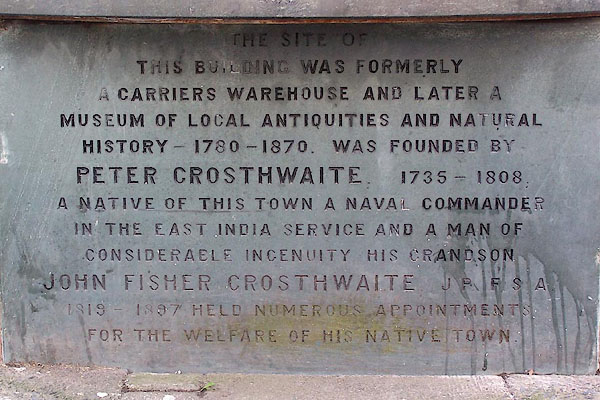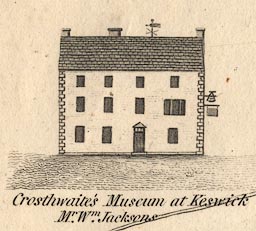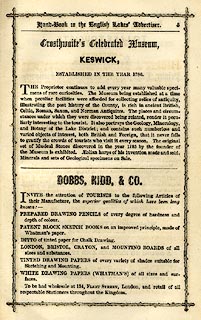 |
 |
   |
|
|
|
gone |
|
Crosthwaite's Museum |
| Street:- |
Main Street |
| locality:- |
Keswick |
| civil parish:- |
Keswick (formerly Cumberland) |
| county:- |
Cumbria |
| locality type:- |
museum |
| coordinates:- |
NY265235 (?) |
| 1Km square:- |
NY2623 |
| 10Km square:- |
NY22 |
|
|
|

BMR05.jpg Plaque, under a sculpture on Main Street:-
"THIS BUILDING WAS FORMERLY A CARRIERS WAREHOUSE AND LATER A MUSEUM OF LOCAL ANTIQUITIES
AND NATURAL HISTORY - 1780-1870. WAS FOUNDED BY PETER CROSTHWAITE 1735-1808 A NATIVE
OF THIS TOWN A NAVAL COMMANDER IN THE EAST INDIA SERVICE AND A MAN OF CONSIDERABLE
INGENUITY ..." (taken 17.9.2006)
|
|
|
| evidence:- |
old map:- Crosthwaite 1783-94 (But/Cru/Low)
placename:- Crosthwaite's Museum
|
| source data:- |
Map, uncoloured engraving, An Accurate Map of Buttermere,
Crummock and Loweswater Lakes, scale about 3 inches to 1 mile,
by Peter Crosthwaite, Keswick, Cumberland, 1794, version
published 1800.

CT08Vgn3.jpg
"Crosthwaite's Museum at Keswick ..."
item:- Armitt Library : 1959.191.2
Image © see bottom of page
|
|
|
| evidence:- |
old text:- Gents Mag
|
| source data:- |
Magazine, The Gentleman's Magazine or Monthly Intelligencer or
Historical Chronicle, published by Edward Cave under the
pseudonym Sylvanus Urban, and by other publishers, London,
monthly from 1731 to 1922.
 goto source goto source
Gentleman's Magazine 1804 p.847 "... ..."
"It is the opinion of many eminent men, that the air of mountains produces a peculiar
animation and cheerfulness. At Keswick we have an account of the museum of Mr. Crosthwaite,
and the rival one of Mr. Hutton, both abounding with curiosities and information;
but the latter has the minerals, though small in number, better arranged."
"..."
|
|
|
| evidence:- |
descriptive text:- Ford 1839 (3rd edn 1843)
item:- geology
|
| source data:- |
Guide book, A Description of Scenery in the Lake District, by
Rev William Ford, published by Charles Thurnam, Carlisle, by W
Edwards, 12 Ave Maria Lane, Charles Tilt, Fleet Street, William
Smith, 113 Fleet Street, London, by Currie and Bowman,
Newcastle, by Bancks and Co, Manchester, by Oliver and Boyd,
Edinburgh, and by Sinclair, Dumfries, 1839.
 goto source goto source
Page 51:- "..."
"[Keswick] ... Here are two museums, exhibiting the geological history of the surrounding
locality, and many foreign curiosities; one was established by the late Mr. Crosthwaite,
and is now kept by his son. At both the museums, the various mineral productions of
the district are exposed for sale. ..."
 goto source goto source
Page 166:- "[Keswick] ... There are two museums, containing many curiosities, and specimens of
the mineralogy and geology of the district. ..."
|
|
|
| evidence:- |
old text:- Martineau 1855
item:- aeolian harp; lifeboat; geology; archaeology
|
| source data:- |
Guide book, A Complete Guide to the English Lakes, by Harriet
Martineau, published by John Garnett, Windermere, Westmorland,
and by Whittaker and Co, London, 1855; published 1855-76.
 goto source goto source
Page 72:- "... Crosthwaite's Museum is also a place of great interest, for its own sake, as well
as that of its founder,- Peter Crosthwaite, the first real explorer, surveyor and
draughtsman of the district, and the inventor of the Aeolian harp, the life-boat (the
reward of which invention he missed through"
 goto source goto source
Page 73:- "carelessness in a government office,) and various other matters, useful or curious.
The museum contains ancient coins, ancient books, and a good geological and mineralogical
collection. It was begun between 70 and 80 years ago; and the founder died in 1808.
It is preserved, improved and exhibited by his descendants."
|
|
|
hearsay:-
|
Peter Crosthwaite did not invent the aeolian harp, which is sometimes credited to
St Dunstan 909-988. The present form of the instrument has been around since the 16th
or 17th century. This is a long wooden box, a resonator, with several strings of different
thicknesses stretched across two bridges, tuned in unison. Wind blowing across the
strings akes them sing, like telephone wires. Peter Crosthwaite made an improved version.
Aeolian harps were made and sold in Westmorland and Cumberland in the 18th and 19th
centuries.
|
|
|
| evidence:- |
old advertisement:- Atkinson 1847 (5th edn 1850)
placename:- Crosthwaite's Museum
|
| source data:- |
Advertisement for Crosthwaite's Celebrated Museum, Keswick, Cumberland, 1850.
 click to enlarge click to enlarge
AK2A03.jpg
At the end of a Handbook to the English Lakes, 5th edn.
item:- Armitt Library : A1144.14
Image © see bottom of page
|
|
|
hearsay:-
|
William Gell commented upon the museum, 1797:-
|
|
"His collection chiefly consists of mineral productions and those indian bows, caps
and ornaments which are to be found in every museum ... His daughter is an elegant
woman and more worth seeing than anything else in his house ..."
|
|
|
hearsay:-
|
Iin the Market Place, a few yards from the Royal Oak, NOT in the old town hall.
|
|
|







 goto source
goto source goto source
goto source goto source
goto source goto source
goto source goto source
goto source click to enlarge
click to enlarge